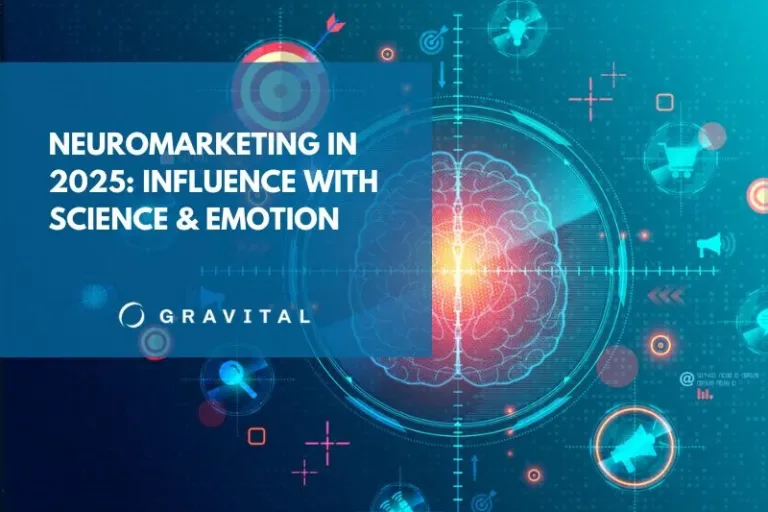Marketing may be defined as the business of promoting products and services, but it’s about much more than that. At the very core of marketing, beyond the products or services being promoted, are the consumers. Understanding what makes them tick is what ultimately determines the success or failure of a marketing campaign.
Brands face a monumental challenge: capturing genuine attention and creating emotional resonance. Traditional marketing tools—surveys, focus groups, A/B testing—only scratch the surface. Enter neuromarketing, the revolutionary field that decodes how the human brain truly responds to marketing stimuli.
At Gravital, we believe that the future of marketing lies not only in data—but in decoding the subconscious. Neuromarketing offers a science-backed approach to uncovering what consumers actually feel, not just what they say.
This is the allure of neuromarketing–an innovative field at the intersection of neuroscience and marketing that is changing the way brands approach marketing. Neuromarketing goes beyond traditional marketing strategies, tapping into the human brain’s intricate workings to understand consumer behavior at a deeper level.
READ ALSO: How To Use Neuromarketing To Grow Your Business: 14 Powerful Tips
What Is Neuromarketing, Really?
Neuromarketing is the application of neuroscience to marketing, aiming to understand how consumers respond to stimuli on a subconscious level. It goes far beyond traditional demographics and surface-level insights to tap into emotions, instincts, and psychological patterns.
Using techniques like fMRI, EEG, eye tracking, and biometric analysis, brands can measure reactions in real time, observing how people feel, where they look, what holds their attention—and why they buy.
This is about emotion-driven strategy, not guesswork.
Imagine peering into the minds of your customers as they experience your product, service or ad campaign. Now you can.
Neuromarketing is a groundbreaking field that applies principles of neuroscience to marketing research, focusing on consumers’ sensorimotor, cognitive and affective response to marketing stimuli. In simpler terms, it’s the science of understanding how consumers’ brains really work and what influences their purchasing decisions.
The term “neuromarketing” was first used in 2002, but research in the field began in the 1990s. But the field’s significant leap came in 2004 with “The Pepsi Challenge,” a blind taste test of Pepsi versus Coca-Cola with “Neural correlates of behavioral preference for culturally familiar drinks.” Although people preferred Pepsi in the taste tests, the area associated with strong brand identification in their brains lit up for Coca-Cola, indicating the power of branding over actual product preference. Since then, numerous studies have shown that consumers’ choices are often driven by subconscious and emotional factors rather than the products and services themselves.
Using sophisticated technologies and techniques, neuromarketing unlocks data that reveals what resonates with consumers on a subconscious and emotional level. This data empowers marketers to create campaigns that speak not just to the conscious mind, but to the primal instincts and emotional triggers that govern decision-making.


Why It Matters in 2025
Today’s consumers make choices in micro-moments—influenced by mood, speed, design, and subconscious emotion. Neuroscience now tells us:
- According to Harvard professor Gerald Zaltman, up to 95% of purchasing decisions happen subconsciously.
- Emotional response to ads influences intent to purchase by up to 3x.
- Eye-tracking studies show that design hierarchy directly affects conversion.
Neuromarketing enables brands to optimize every touchpoint—emotionally, visually, and cognitively.
Key Techniques Driving Innovation
- EEG & Brainwave Monitoring
Understand which campaigns evoke joy, trust, or confusion, and adapt messaging accordingly. - Eye Tracking
Analyze visual hierarchy: What are users really paying attention to? - Facial Expression Analysis
Capture micro-reactions to predict emotional alignment and product appeal. - Biometric Feedback (GSR, HRV)
Gauge arousal, stress, and excitement in real time. - AI-Powered Psychographic Profiling
Match consumers not by age or location, but by values, beliefs, and behavior.
Techniques and Technologies Used in Neuromarketing
Functional Magnetic Resonance Imaging (fMRI)
This technology measures brain activity by detecting changes in blood flow. When an area of the brain is more active, it consumes more oxygen, and blood flow to that area increases. fMRI provides insights into which areas of the brain are activated by certain marketing stimuli, certain emotional responses, and decision-making processes.
Electroencephalography (EEG)
EEG records the electrical activity of the brain using small, flat metal discs (electrodes) attached to the scalp. It’s particularly useful for measuring consumer engagement, emotional responses and attention spans in reaction to marketing materials in real-time.
Eye Tracking
This technology tracks where and how long a person looks when viewing an advertisement, website or other media. By studying eye movement patterns, marketers can discern which aspects of an ad or product packaging grab attention and maintain interest.
Galvanic Skin Response (GSR)
GSR measures the electrical conductivity of the skin, which varies with its moisture level. GSR is used in neuromarketing to gauge consumer emotional arousal in response to stimuli.
From the Brain to the Brand: Real Applications
Optimized Content & Website Design
By analyzing attention patterns and emotional peaks, Gravital helps clients design neuro-intuitive content that boosts engagement and retention.
Emotionally Intelligent Campaigns
We fine-tune storytelling to tap into the exact emotional triggers that drive action—be it excitement, nostalgia, or a sense of belonging.
Data-Driven Product Packaging
Shape consumer perception at the shelf level by testing emotional and visual reactions to packaging—before you go to market.
Next-Level Personalization
Our neuromarketing approach combined with AI allows for hyper-targeted, emotionally congruent messaging—increasing click-throughs, conversions, and customer loyalty.
Understanding Consumers
The days of relying solely on surveys and focus groups–which we all know can be subject to biases and misinterpretations–are over. Neuromarketing bypasses these limitations, offering a direct window into the unfiltered world of consumer preferences.
Through the lens of brain activity and physiological responses, marketers can observe and measure various aspects of consumer perception and behavior.
Neuromarketing examines:
- Emotional responses: Neuromarketing looks at how certain marketing stimuli trigger emotional responses in the brain. For instance, certain colors or images used in a campaign might evoke happiness or nostalgia, which can influence a consumer’s inclination toward a product.
- Decision making: The prefrontal cortex is critical in decision-making processes. Neuromarketing studies how different stimuli can activate this part of the brain, influencing choices and preferences.
- Reward system activation: The brain’s reward system plays a crucial role in the perception of value and pleasure. Neuromarketing explores how certain marketing tactics can stimulate this system, making products more appealing.


Neuromarketing reveals:
- Emotional engagement: Which elements of your campaign evoke positive emotions like excitement, joy or trust?
- Attention allocation: Where do viewers’ eyes linger, and what elements hold their attention longest?
- Memory encoding: What aspects of your brand or product leave a lasting impression in the minds of consumers?
- Decision-making processes: What subconscious factors influence choices at the point of purchase?
Notable Examples of Neuromarketing in Action
Microsoft’s Emotional Engagement
Microsoft employed neuromarketing techniques, particularly EEG, to measure users’ emotional engagement with the Xbox and other Microsoft products. This helped it refine user interfaces and experiences.
PayPal Ads
PayPal used neuromarketing research to test different ad versions and found that ads focusing on security and ease-of-use resonated more with audiences. The company shifted its campaign based on these findings.
Hyundai’s Car Design
Hyundai has used EEG and eye-tracking technologies to test consumer reactions to car designs. This neuroscientific approach has influenced design decisions to make cars more appealing to potential buyers. Also, Hyundai has made significant investments in state-of-the-art virtual reality (VR) technology and infrastructure to transform its design process.
Campbell’s Soup Product Packaging
Neuromarketing research prompted the brand to redesign its soup cans to create a more emotionally appealing look, which resulted in increased sales.
In addition, film studios have used neuromarketing research to analyze viewers’ responses to movie trailers, allowing the studios to tweak content or marketing strategies to ensure better box office success.
Don’t Just Market. Emotionally Connect
In today’s landscape, emotional intelligence isn’t a nice-to-have. It’s a strategic advantage. Neuromarketing bridges the gap between what consumers think they want and what actually drives them to act.
At Gravital, we go beyond data—we dive deep into the emotions, perceptions and reactions that shape decisions. That’s how we create marketing strategies that not only perform but deeply resonate.
Your next campaign shouldn’t just speak to minds—it should move hearts.
If you’re not yet capitalizing on neuromarketing, you’re missing out. Our team of experts can help you integrate these cutting-edge insights into your marketing strategies and transform your brand and your business. Talk to us.


